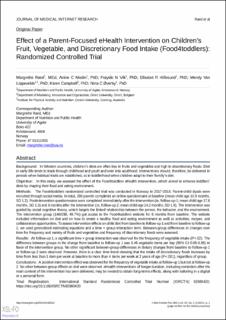| dc.contributor.author | Røed, Margrethe | |
| dc.contributor.author | Medin, Anine Christine | |
| dc.contributor.author | Vik, Frøydis Nordgård | |
| dc.contributor.author | Hillesund, Elisabet Rudjord | |
| dc.contributor.author | Van Lippevelde, Wendy | |
| dc.contributor.author | Campbell, Karen | |
| dc.contributor.author | Øverby, Nina Cecilie | |
| dc.date.accessioned | 2021-08-16T12:48:21Z | |
| dc.date.available | 2021-08-16T12:48:21Z | |
| dc.date.created | 2021-02-23T08:52:07Z | |
| dc.date.issued | 2021 | |
| dc.identifier.citation | Røed, M., Medin, A. C., Vik, F. N., Hillesund, E. R., van Lippevelde, W., Campbell, K. & Øverby, N. C. (2021). Effect of a Parent-Focused eHealth Intervention on Children’s Fruit, Vegetable, and Discretionary Food Intake (Food4toddlers): Randomized Controlled Trial. Journal of Medical Internet Research, 23(2): e18311. | en_US |
| dc.identifier.issn | 1438-8871 | |
| dc.identifier.uri | https://hdl.handle.net/11250/2768061 | |
| dc.description.abstract | Background: In Western countries, children’s diets are often low in fruits and vegetables and high in discretionary foods. Diet in early life tends to track through childhood and youth and even into adulthood. Interventions should, therefore, be delivered in periods when habitual traits are established, as in toddlerhood when children adapt to their family’s diet.
Objective: In this study, we assessed the effect of the Food4toddlers eHealth intervention, which aimed to enhance toddlers’ diets by shaping their food and eating environment.
Methods: The Food4toddlers randomized controlled trial was conducted in Norway in 2017-2018. Parent-child dyads were recruited through social media. In total, 298 parents completed an online questionnaire at baseline (mean child age 10.9 months, SD 1.2). Postintervention questionnaires were completed immediately after the intervention (ie, follow-up 1; mean child age 17.8 months, SD 1.3) and 6 months after the intervention (ie, follow-up 2; mean child age 24.2 months, SD 1.9). The intervention was guided by social cognitive theory, which targets the linked relationship between the person, the behavior, and the environment. The intervention group (148/298, 49.7%) got access to the Food4toddlers website for 6 months from baseline. The website included information on diet and on how to create a healthy food and eating environment as well as activities, recipes, and collaboration opportunities. To assess intervention effects on child diet from baseline to follow-up 1 and from baseline to follow-up 2, we used generalized estimating equations and a time × group interaction term. Between-group differences in changes over time for frequency and variety of fruits and vegetables and frequency of discretionary foods were assessed.
Results: At follow-up 1, a significant time × group interaction was observed for the frequency of vegetable intake (P=.02). The difference between groups in the change from baseline to follow-up 1 was 0.46 vegetable items per day (95% CI 0.06-0.86) in favor of the intervention group. No other significant between-group differences in dietary changes from baseline to follow-up 1 or follow-up 2 were observed. However, there is a clear time trend showing that the intake of discretionary foods increases by time from less than 1 item per week at baseline to more than 4 items per week at 2 years of age (P<.001), regardless of group.
Conclusions: A positive intervention effect was observed for the frequency of vegetable intake at follow-up 1 but not at follow-up 2. No other between-group effects on diet were observed. eHealth interventions of longer duration, including reminders after the main content of the intervention has been delivered, may be needed to obtain long-terms effects, along with tailoring in a digital or a personal form. | en_US |
| dc.language.iso | eng | en_US |
| dc.publisher | JMIR Publications | en_US |
| dc.rights | Navngivelse 4.0 Internasjonal | * |
| dc.rights.uri | http://creativecommons.org/licenses/by/4.0/deed.no | * |
| dc.title | Effect of a Parent-Focused eHealth Intervention on Children's Fruit, Vegetable, and Discretionary Food Intake (Food4toddlers) : Randomized Controlled Trial | en_US |
| dc.type | Journal article | en_US |
| dc.type | Peer reviewed | en_US |
| dc.description.version | publishedVersion | en_US |
| dc.rights.holder | © 2021 The Author(s) | en_US |
| dc.subject.nsi | VDP::Medisinske Fag: 700::Helsefag: 800::Ernæring: 811 | en_US |
| dc.source.pagenumber | 18 | en_US |
| dc.source.volume | 23 | en_US |
| dc.source.journal | Journal of Medical Internet Research | en_US |
| dc.source.issue | 2 | en_US |
| dc.identifier.doi | https://doi.org/10.2196/18311 | |
| dc.identifier.cristin | 1892604 | |
| dc.relation.project | Universitetet i Agder: 689019 | en_US |
| dc.source.articlenumber | e18311 | en_US |
| cristin.qualitycode | 2 | |

